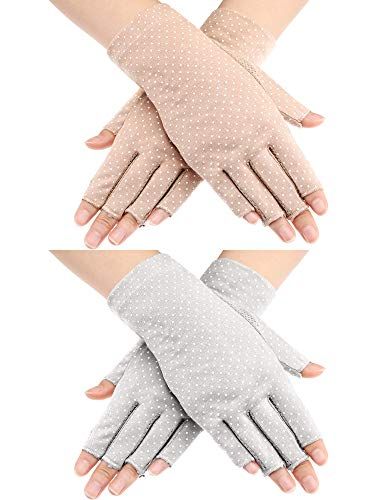
- New research shows that UV-nail polish dryers, typically used to cure gel manicures, can cause DNA damage in your hands.
- UV rays are known to cause skin cancer at high exposures, but very little safety research has been done on the lamps used for manicures.
- Dermatologists explain the safety of UV dryers and how to better protect your hands.
Gel manicures can be a great long-lasting option for nails—they practically guarantee chip-free digits. But, new research shows that frequent gel manicures with UV-nail polish dryers can cause damage to DNA in hands.
A study published in Nature Communications shows that getting your nails done frequently, specifically using UV rays to cure a gel manicure, could damage the DNA in your hands, which could lead to skin cancer. Ultraviolet (UV) rays are known to cause skin cancer at high exposures, and yet very little safety research has been done on the lamps.
In a press release, researchers from the University of California San Diego explained that the common devices in nail salons generally use a particular spectrum of UV light (340-395nm) to cure the chemicals used in gel manicures. While tanning beds use a different spectrum of UV light (280-400nm) that studies have proven to be carcinogenic, or cancer-causing, the spectrum used in the nail dryers has not been extensively studied.
“If you look at the way these devices are presented, they are marketed as safe, with nothing to be concerned about,” said Ludmil Alexandrov, a professor of bioengineering and cellular and molecular medicine at UC San Diego, and corresponding author of the study. “But to the best of our knowledge, no one has actually studied these devices and how they affect human cells at the molecular and cellular levels until now.”
Researchers looked at three populations of cells, including both human skin cells and connective tissue from mice, to look at the effect of the UV-nail dryers on health. They found that using the device for just one 20-minute session led to 20 to 30% cell death, while three consecutive 20-minute exposures caused between 65 to 70% of the exposed cells to die. Exposure to UV light seen in the study also caused mitochondrial and DNA damage in the remaining cells and resulted in mutations with patterns that can be observed in skin cancer in humans.
“We saw multiple things: first, we saw that DNA gets damaged,” said Alexandrov in a press release. “We also saw that some of the DNA damage does not get repaired over time, and it does lead to mutations after every exposure with a UV-nail polish dryer. Lastly, we saw that exposure may cause mitochondrial dysfunction, which may also result in additional mutations. We looked at patients with skin cancers, and we see the exact same patterns of mutations in these patients that were seen in the irradiated cells.”
While the results show the harmful effects of the repeated use of these devices on human cells, researchers caution that a long-term study would be required before coming to the conclusion that using these machines leads to an increased risk of skin cancers. However, the results of the study were clear: the chronic use of these nail polish drying machines is damaging to human cells.
How does UV light damage your skin and DNA?
According to the skin cancer foundation, 90% of the visible signs of aging come from daily exposure to UV light. This means fine lines, wrinkling, saggy skin, sun spots, uneven skin tone, says Mona Gohara, M.D., associate clinical professor of dermatology at Yale School of Medicine and Prevention Medical Review Board member. “In addition, it can alter one’s DNA repair mechanisms, making skin cancer possible.” And according to the foundation, more people are diagnosed with skin cancer each year in the U.S. than all other cancers combined.
UV radiation is a proven carcinogen and excessive exposure can cause basal cell carcinoma (the most common form of skin cancer) and squamous cell carcinoma, notes Dana Stern, M.D., board-certified dermatologist and founder of Dr. Dana. “Fortunately, when discovered early and effectively treated, these common skin cancers are usually curable.”
How often is it safe to get gel manicures?
If you are using broad-spectrum sunscreen of SPF 30, 30 minutes prior to exposure with a fingertip-less glove, then you can enjoy frequent UV-cured manicures as long as your nails are tolerating them, says Dr. Stern. “If you are not protecting your skin, then the answer is more murky and difficult to advise at this time.”
UV light with manicures can always pose a risk, says Dr. Gohara. LED lights pose less of a risk, but could still pose some potential dangers. “It’s kind of analogous to smoking a cigarette, the more you do it, the more at risk you are. If you want to be sure that no exposure is happening, use sunscreen, cover your hands with cotton gloves, or avoid manis that involve light devices.”
Basically, any exposure to UV rays comes with some risk, but experts say less is more. “Three to four times a year is certainly better than every two weeks but there will always be a certain amount of risk,” says Peterson Pierre M.D., board-certified dermatologist at the Pierre Skin Care Institute.
The bottom line
While this study is certainly alarming, the knowledge that UV radiation exposure causes DNA mutation in the skin is not new, says Dr. Stern. “We know that UV radiation is a known and proven risk for skin cancer and this is why we wear sunscreen, sun protective clothing, hats, sit in the shade and ideally have regular skin checks with a board-certified dermatologist.”
At this point in time, it is difficult to quantify the risks of UV-A exposure during repeated gel manicure sessions, Dr. Stern adds. “There is so much variability with respect to the types of lamps, bulb life, exposure times, positioning of the skin relative to the light, skin types being exposed, and manicure frequency. We do know that repeated exposure to UVA is mutagenic and can cause skin cancer, the question remains as to how much of a risk typical gel manicures pose.”
For anyone getting UV gel manicures, it is advisable to protect the skin with a UV protective barrier such as fingertip-less UV protective gloves as well as broad-spectrum sunscreen applied 30 minutes before the gel manicure, advises Dr. Stern. “It is key that the sunscreen is broad-spectrum in order to protect against UVA rays.”
But, there may be a risk with any type of light device used in a manicure, says Dr. Gohara. “The risk could be skin cancer or skin changes. The more one uses light-based devices for manicures the more they are at risk for adverse skin events.”
The best way to protect your hands from UV radiation, in general, is to wear sunscreen daily, says Dr. Gohara.

Madeleine, Prevention’s assistant editor, has a history with health writing from her experience as an editorial assistant at WebMD, and from her personal research at university. She graduated from the University of Michigan with a degree in biopsychology, cognition, and neuroscience—and she helps strategize for success across Prevention’s social media platforms.
















